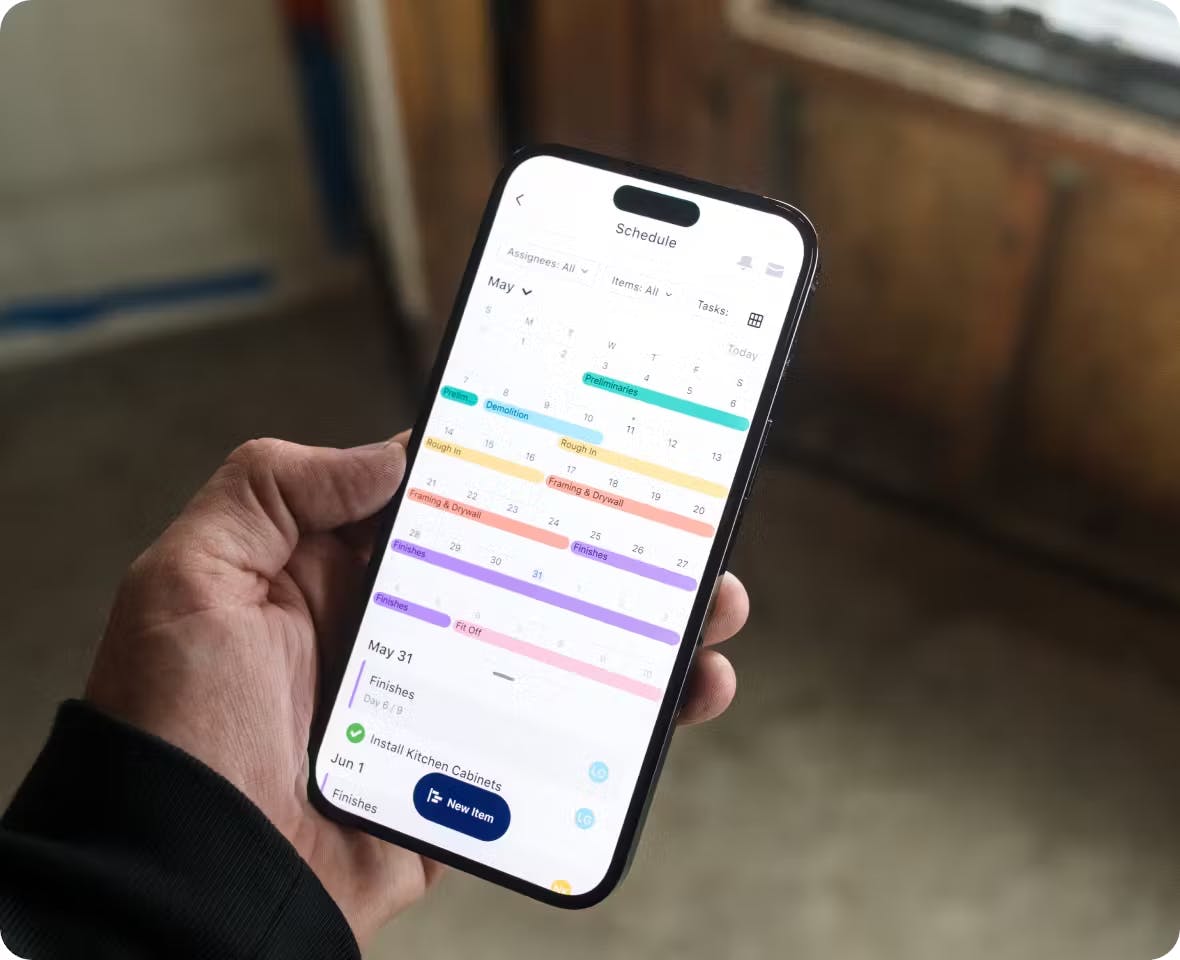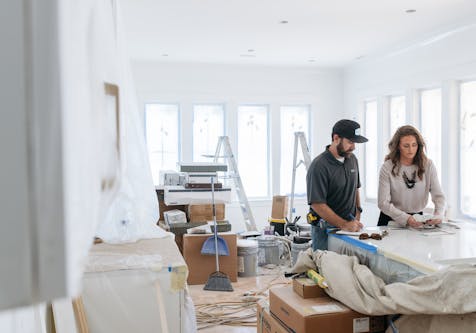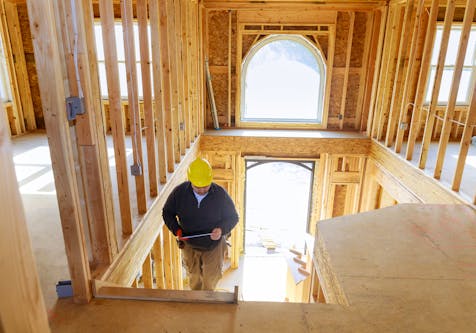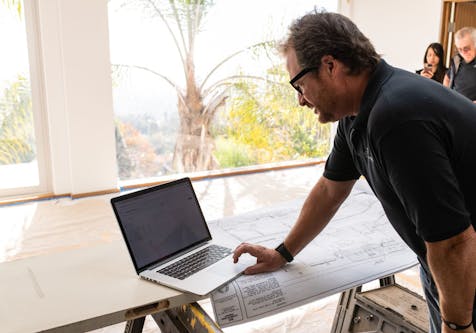Tips for Keeping Construction and Design Projects on Track
How Pros manage their time efficiently and the tools they use to do it

Today, completing projects on time, and avoiding cost overruns is more important than ever for interior designers and contractors to be successful. Delivering quality work within the promised timeline starts and ends with a single word: Scheduling.
In this article, we offer tips and tools for mastering scheduling techniques and effective time management in construction and design work. Using these strategies can help you keep your projects on track while also reducing the time you devote to managing project timelines so you will have more time for the work you love.
A Houzz survey of interior designers shows that 2 out of 5 designers - or roughly 44 percent - work more than 40 hours per week with some exceeding 50 hours weekly. Not only will you get more time back if you streamline your scheduling process, but doing so can help you increase productivity and profitability.
Why Scheduling is Crucial
Both interior designers and contractors rely heavily on effective time management to ensure that projects stay on track and are completed within the agreed-upon timeframe. Scheduling plays a vital role in keeping everyone involved accountable and ensuring that tasks are completed in a timely manner.
From coordinating with subcontractors to ordering materials, there are numerous tasks that contractors and designers need to complete in a specific order and within a certain timeframe. Without effective scheduling, projects can easily become delayed, resulting in frustrated clients and potential financial losses.
With multiple clients and projects to juggle, it can be hard to stay organised and keep track of every single deadline. By implementing an intuitive scheduling system, home improvement pros can prioritise tasks, and manage their time effectively to ensure that each project receives the attention it deserves.
Having the right tech tools greatly reduces the learning curve, and burden of managing projects and juggling schedules. Susan Heinz, co-founder of the Heinz Group boutique residential construction business, uses Houzz Pro Schedule to keep the company’s construction projects on track and share schedules with everyone who needs to know. "The Schedule feature is just amazing,” she says. “Clients can see exactly how their project is progressing and we can see which trade we have scheduled. It is really nice that you can get as detailed and granular as you want with the ability to add notes and schedule specific arrival times.”

Houzz Pro Schedule recognises the interconnectivity of the phases, items and tasks involved in every project. Phases allows pros to input all the particulars that make up a phase of a job. When you create a phase you can determine its length and by assigning items to that phase, you can build out your schedule to estimate exactly how long the project should take. Then, by assigning tasks to team members within each item you will keep everyone in sync.
Making sure that the right information goes to the right person cuts through the noise so everyone knows their role. Heinz uses Houzz Pro for Project Collaboration to do just that. “That is where we keep everything related to a job, and I love that you can select the viewing permissions for each user to keep the sharing of information highly efficient,” she says. “We collect a lot of information for a project and not everyone needs to see every file we have.” she says.
The Schedule feature also makes it easy to share the timeline you’ve set with subcontractors. It shows dependencies to provide clarity for everyone involved. Let’s say the insulation of a wall is delayed, the subcontractors who are doing the drywall and the others who are doing the stucco, are notified that they will not be able to start their work as originally scheduled.
This helps keep projects on track so you can quickly change up the schedule and focus on getting other tasks finished in the meantime.

Set Clear Goals and Milestones
One of the most important aspects of effective scheduling in interior design and construction projects is setting clear goals and milestones for the project. This helps ensure that everyone is on the same page and understands what needs to be accomplished and by when. This brings better collaboration and minimises the risk of misunderstandings or miscommunications.
A roadmap breaking down the project into smaller, manageable tasks can serve as a guide for how pros can allocate their time and resources to meet the deadlines set for each phase of the project. Setting milestones also helps you track progress and make adjustments if necessary. That starts with having an effective and efficient tracking process.
Trevor Fulmer of Trevor Fulmer Design in Boston tracks everything using Houzz Pro. “We really do all of our time tracking through Houzz Pro. That’s super important,” he says. He tracks products and purchases after finding them in Houzz Pro and adds them to proposals and invoices. This allows him to track everything, knowing when something is ordered, when it is shipped and when it arrives, he says.
By clearly defining what needs to be accomplished at each stage of the project, everyone involved has a better understanding of the timeline and what is expected, making for smoother collaboration and reducing the risk of misunderstandings or delays.
“We’re a luxury business in a luxury industry, and it’s important that we be able to streamline and keep our process organised,” he explains, “and be able to communicate to our clients efficiently.”

Prioritise Tasks and Set Deadlines
As an interior designer or contractor, you have a multitude of tasks to juggle, from selecting materials to coordinating with subcontractors and keeping clients up to date. When you prioritize tasks and set deadlines, it sets the expectations for clients, other team members and subcontractors.
Start by creating a list of all the tasks that need to be completed, such as selecting furniture, choosing paint colors, or coordinating with tradespeople and contractors. Then, assess the urgency and importance of each task. Identify those that are critical to the overall project timeline and prioritise those first. By doing this, you can ensure that the most time-sensitive tasks are completed on schedule, while allowing for flexibility to handle less urgent tasks.
When determining a timeline for each task, be realistic in how long it will take to accomplish it. Consider factors such as the complexity, availability of resources, and potential dependencies. Communicate these deadlines clearly with your team members and any subcontractors involved in the project. This will ensure that everyone is aware of the expectations and can plan their work accordingly.
By prioritising tasks and assigning deadlines, you can stay organised and ensure that you are dedicating enough time to each aspect of the project. This will help you avoid rushing through tasks and ensure that the final result meets your client's vision. Managing time effectively and avoiding unnecessary delays is also important when working with subcontractors who rely on clear deadlines to plan their own work.

Delegate, Delegate, Delegate
It can be tempting to try and do everything yourself to maintain control over every aspect of a build or remodeling project. However, this can lead to burnout and delays because you are trying to handle too much at once. Delegating tasks to your team members or subcontractors, frees up your time to focus on more important aspects of the project.
When delegating, consider the strengths and expertise of each team member. Assign tasks to individuals who are best suited for the job, and clearly communicate your expectations and deadlines. By entrusting others, you can benefit from their expertise to complete the project more efficiently.
Delegating tasks also helps build a sense of teamwork and collaboration among your team members. It allows them to take ownership of the job and contribute to the overall success of the project. So, don’t hesitate to delegate tasks and empower your team to help you manage your projects more effectively.

Plan for the Unexpected
When it comes to construction projects, unexpected delays and emergencies happen, causing frustration, setbacks and even budget overruns. Try to avoid surprises by anticipating potential obstacles that could disrupt the timeline. Consider delays in materials and products; anticipate clients changing their minds about aspects of the design plans, and of course, figure in possible weather-related work stoppages.
Having a contingency plan can help minimize the impact of these setbacks. Allow for extra time in your schedule to account for these unexpected issues that may arise. Also communicate the plan with your clients so that they understand the potential risks involved and can make informed decisions. And, maintain a list of backup suppliers and subcontractors who can step in if your original choices fall through.
When the inevitable delays do occur, having a robust and up to date schedule can minimize the impact of any delays. Having instant visibility on who has been affected you can alert the stakeholders to the delays and reschedule them if necessary. By having these clear and open lines of communication you can avoid onsite chaos.

Build a Collaborative Team Environment
When all members of the team are working together effectively, projects are more likely to stay on track and be completed within the agreed-upon timeframe. This means fostering a collaborative team environment involves clear and open communication with contractors, subcontractors, and other team members. By establishing regular check-ins, everyone can stay informed about the progress of the project and address any potential issues or bottlenecks.
This creates a sense of cohesion and accountability, as each team member understands their role and responsibilities in the overall project timeline. Collaboration also means valuing and leveraging the expertise of each team member.
As an interior designer, you may have a vision for the project, but the input and insights of contractors and subcontractors can make it even better. Contractors who establish clear lines of communication with interior designers and subcontractors help ensure that everyone is working towards a common goal.
This means being transparent about project expectations, deadlines, and any changes that may arise.
Houzz Pro makes working as a team as seamless as possible and helps assure the right information goes to the right people. There are three default roles for team members, making it easy for you to set permissions: Admin, Field Crew or Design Team and Finance. Each role comes with default permissions to allow access to projects and features which can be fully customised in the team member dashboard. You can add as many team members as you have in your business.
It also makes it simply for other team members and busy subcontractors to review the project details and know their role.
“I’ve found that when I was sending plans [to subcontractors] through email, they were constantly losing them, or they have so many emails, they don’t know which one they’re working with,” says Matt Hoots, a contractor of SawHorse Design+ Build in Atlanta. Now he shares the files using Houzz Pro instead. “If I send it through Houzz, it’s stored as a file on Houzz so they always have access to it. They log back in, and they always know where to go to get the plans and specs.”

Evaluate Your Workflow
One way to streamline your workflow is to evaluate your current processes and identify areas where improvements can be made. Are there any redundant or unnecessary steps that can be eliminated? What tools or technologies that can automate certain tasks? By streamlining your workflow, you can eliminate inefficiencies and save time.
It’s also important to identify and address any bottlenecks in your workflow where tasks or information get delayed or stuck, causing a slowdown in progress. By pinpointing these bottlenecks, you can take proactive measures to resolve them and keep your projects moving smoothly.
To identify bottlenecks, review your project timeline and analyse where delays tend to occur. Is there a particular task or phase of the project that consistently takes longer than expected? Are there any dependencies or constraints that are causing delays? By identifying these bottlenecks, you can make the necessary adjustments to prevent them from happening in future projects. This may involve reassigning tasks, reallocating resources, or implementing new strategies to overcome obstacles. By addressing the bottlenecks head-on, you can keep your projects on track and ensure that you are making the most efficient use of your time.

Be an Effective Communicator
Regular and open lines of communication with both clients and contractors are essential for staying on schedule and ensuring that everyone is on the same page. By regularly checking in with clients, you can ensure that their needs and expectations are being met and you can make any necessary adjustments or revisions to the design plan, ensuring that the end result aligns with their vision.
Frequent communication also lets you address any concerns or issues as they arise instead of after the fact. By clearly communicating deadlines and milestones with clients, you can ensure that everyone is aware of the project timeline and can plan accordingly. This not only builds trust but also allows for better collaboration and decision-making because it produces more effective problem-solving and helps you manage your time and resources efficiently.

Step Back and Learn
After successfully completing a project, it's important for both interior designers and contractors to take the time to review and analyse their performance. This step helps you improve future projects and refining your time management strategies. By reflecting on the project as a whole and identifying areas for improvement, you can continuously evolve and optimise your time management skills.
Consider whether you met all the deadlines and milestones that were set, and if not, identify the reasons why. Were there any specific tasks or phases of the project that took longer than expected? Did you effectively coordinate with subcontractors and ensure that tasks were completed in a timely manner? Were there any challenges or delays that you could have mitigated?
Ask your clients about their overall satisfaction with the project and if there were any areas that could have been improved in terms of timing and scheduling. Collect feedback from your team members and subcontractors to understand their perspectives on the project and identify any areas for improvement. This feedback can be invaluable in refining your time management strategies and ensuring that you continue to deliver exceptional results, and the referrals keep coming in.
After 15 years in the industry, Best of Houzz winner interior designer Nicole Arnold says her biggest lesson has been understanding the importance of growing her interior design business through reputation and customer referrals. “When we do a great job for our clients, then receive recognition, like Best of Houzz, it further reinforces that we are doing the right things,” she says.





